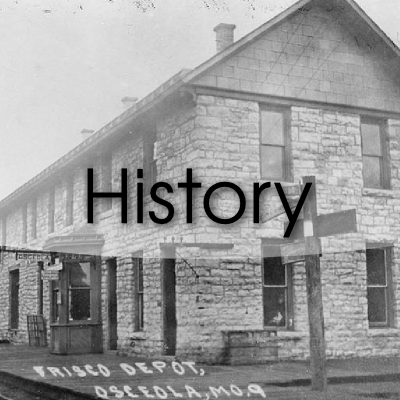By: Judith Guthrie and Richard F. Sunderwirth
In 1831, an early pioneer, Jacob Coonce erected the first cabin in St. Clair County, about a mile and a half west of the Sac River in Roscoe Township. Here he drove his first stake and shortly after that the first planted crops began to surface and the county was well on its way.
In the General Assembly of the State of Missouri in 1834, the county of Lillard was divided, and Rives, which is now Henry and St. Clair were established. In 1835, since St. Clair County was not populous enough to warrant organization as a distinct municiplality, it was attached to the county of Rives for civil and military purposes. At that time the county was divided into two townships, Monegaw and Weaubleau. Then in 1841, St. Clair County became its own independent municipality and by order of the circuit court it was determined that Osceola was to be the county seat.
In 1845, at the general session of the State Legislature, the present boundaries of the county were set and the county court divided it into six townships, Monegaw, Speedwell, Washington, Polk, Osceola, and Jackson. Later on, as other villages came into existence, other townships were established. Some villages and communities, through the years, have come and gone.
Appleton City and Osceola have always been the largest towns in the county, with Monegaw Springs, at one time, not far behind. Monegaw came into prominence before the Civil War, when a board of medical experts declared the water of the springs to have medical value. It's greatest growth, however, came after 1870, when with railroad and river boat travel, the town became a popular spa area.
Roscoe dates back to 1839, when David Huffman established a ferry across the Osage River. Although one of the oldest towns, it was not incorporated until 1868.
Many of our early settlements did not become towns until the railroads were built. Appleton City, platted in 1870, with the arrival of the Tebo and Neosho Railroad, Lowry City, platted in 1871 and served by two railroads, the Kansas City, Clinton & Springfield and the St. Louis-San Francisco.
Vista, Collins and Gerster also dated from this time when they were also served by the railroads. The village of Taberville was laid out in 1859 and has always been a village. At one time it was considered to be at the head of navigation on the Osage River.
St. Clair County has always been an agricultural county, with very little manufacturing, especially after the Civil War. Several towns had grist and roller mills, but the county's principal products were agricultural.









